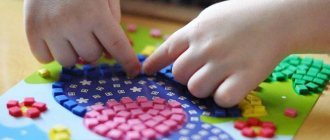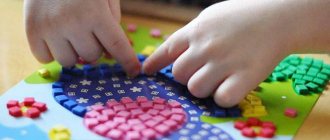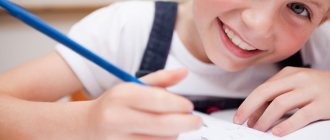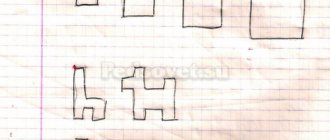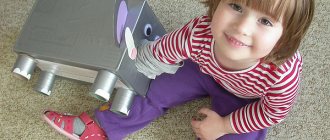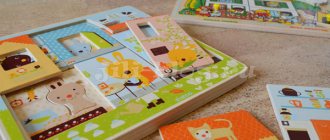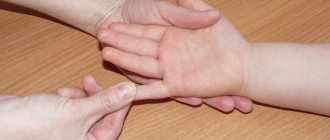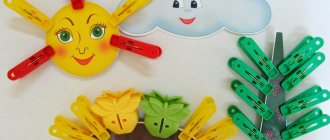Child psychologists have proven that the brain is directly related to a child’s ability to use his hands and fingers and perform various actions with them. That's why parents need to play games with their children to gradually develop fine motor skills. Training should be carried out regularly, be varied and not tire the child.
Definition
Fine motor skills are a set of movements performed by the fingers and hands. It is extremely important to develop it for several reasons.
- Through such activities, the internal organs of the baby are affected. Exercise has a beneficial effect on brain development.
- The ability to perform movements with fingers and hands is most often an indicator that the child is fully developing.
- Finger movements are directly related to speech centers in the cerebral cortex, so experts recommend training your hands in parallel with speech development. Moreover, doing motor skills exercises will help those children who suffer from speech impediments begin to speak better.
Work on fine motor skills should begin from a very early age. Even babies have their fingers massaged, but older children need to learn to perform basic actions on their own. This will be helped by special play exercises that are interesting and useful for kids.
Development of fine motor skills in children 4-5 years old
Master class “Development of fine motor skills of hands in children of middle preschool age”
Rasskazenkova Olga Nikolaevna Educator Municipal state-owned preschool educational institution “Kindergarten No. 27” Dear colleagues, today I want to share with you my experience in using didactic games to develop fine motor skills in middle-aged children, which can be done both in kindergarten and Houses.
(Fine motor skills are a set of coordinated actions aimed at accurately performing small movements with the fingers and hands and feet. The nervous, muscular, skeletal and even visual systems take part in this. It includes a variety of movements: from all the usual gestures to the smallest manipulations. ) an important factor in the success of a child’s intellectual and psychophysical development. At all stages of a child's life, hand movements are very important. The most favorable period for the development of a person’s intellectual and creative capabilities is from 3 to 9 years, when the cerebral cortex has not yet been fully formed. It is at this age that it is necessary to develop memory, perception, thinking, attention. (“The origins of children’s abilities and talents are at the tips of their fingers. From the fingers, figuratively speaking, come the finest streams that feed the source of creative thought.” V.A. Sukhomlinsky) The development of fine motor skills is important because the child’s entire future life will require the use precise, coordinated movements of the hands and fingers, which are necessary to dress, draw, write, and also perform a wide variety of everyday and educational activities. The development of manual skill and fine motor skills is also important for the personal development of the child himself. By owning a hand, a child in the process of his development becomes more independent, autonomous and independent from an adult, which contributes to the development of his initiative in various types of children's activities. According to the Federal State Educational Standard for Preschool Education, among the target guidelines at the stage of completing preschool education, it is noted that the child shows initiative and independence in various types of activities - play, communication, the child has developed fine motor skills; he can control and manipulate his movements. A consequence of poor development of fine motor skills of the hand is the general unpreparedness of most children for writing or a problem with speech development. Children with poorly developed manual motor skills awkwardly hold a spoon or pencil, cannot fasten buttons, or lace up shoes. It can be difficult for them to collect scattered parts of the construction set, to work with puzzles, counting sticks, and mosaics. The Federal State Educational Standard for Education tells us that the development of a child should occur in “forms specific to the development of a given age group, primarily in the form of a game,” which is why in my work I use didactic games that allow me to actively develop the fine motor skills of the children in my group. There are many such games, I want to present those that we made together with our parents. Organizational point: we may not know each other well, but I hope we will understand each other, and games will help us with this, we will take them with us. Look what a beautiful bunch of grapes I have, I’ll now tear off one berry from it and tell you my name - my name is Olga Nikolaevna. Pass the bunch on, each “berry” says its name.
Well, here we are. A bunch of grapes consists of different berries, and we are all different. The berries are on a branch together, holding on tightly to it, so we will play games together and exchange work experience. Take the hands of the one sitting next to you, feel the warmth of the hands of your colleagues, who will be your good helpers. With the help of the organizational moment, I create a favorable atmosphere for the upcoming activity, which from the first minutes promises to be exciting, unusual and interesting. I suggest going on a tour of the autumn park. And to keep us warm, we need to put on a coat (hand out coat templates and offer to fasten the buttons). While working, read a poem: the buttons on Verochka’s coat are harmful, the girl’s poor fingers are suffering. The buttons seem to mock Vera, jumping like squirrels, breaking off the threads. Angry tears are rolling down, your brow is frowning sternly, shouldn’t you wear a dress outside in the fall?
With children, you can make playing with buttons exciting, during which you can set various didactic tasks: developing fine motor skills, eye, concentration, perseverance, consolidating knowledge of colors, size, learning to count. One, two, three, four, five - we continue to play, so that our hands do not freeze, we need to warm our hands (game “Hands with elastic bands”). Take two models each and complete the task according to the sample. While working, read the poem: Masha put on her mitten, oh, where am I going? The finger is missing, it’s gone, it didn’t make it to my little house. Masha took off her mitten - hello, little finger, how are you? (play with your fingers). Children love such games very much, they develop thinking, attention, speech, because children can repeat the poem together with the teacher.
My daughter has boots, they are as good as in the picture, but one of all the problems is that my daughter doesn’t like them at all. She doesn’t like laces, they are difficult to deal with (hand out the game “Lacing Shoes”). It’s terrible how much flour it takes to lace up 2 pieces! Slippery, stubborn, mischievous ones. Then the laces came to their senses and were stuck into the holes.
This game can keep your child busy for a long time. What seems so simple and uninteresting to us adults captivates the child and, at the same time, develops his motor skills. This exercise is especially good for training finger coordination. It requires extreme concentration and contributes to the accuracy of the eye. We are dressed and wearing shoes, we can go out for a walk - I suggest collecting a bouquet of leaves for mom (game “Autumn Bouquet”). We will collect birch leaves, rowan leaves, poplar leaves, aspen leaves, oak leaves and take an autumn bouquet to mom. “Autumn Bouquet” is another one of children’s favorite games, with its help we develop fine motor skills, imagination, attention, coordination of movements, speech, and consolidate form. It can be transformed into the games “Which tree is the leaf from”, “Run to the tree”.
We were walking around the park and watching everyone, suddenly, out of nowhere, mice came running (hand out templates, offer to make the mice eyes, nose, ear and braid the tail).
At this time, perform physical. a moment with the jury members. First, let’s warm up our fingers (rubbing the pencil on our palms), exercise “Crane” - we lift the pencil, press it firmly with our finger, “Iron” - I will swing the pencil, from left to right as I want. Such games with a pencil can be played with children while working in notebooks, and recommended to parents for individual work at home. Make paws for your mouse: the mouse was in a hurry to visit and got ready for the journey (your mice ran), the mice stole the cheese, threw a feast in the hole (play with the cheese). Everything is upside down, burrum-burum, gnawing-gnawing-gnawing and crunch, crunch, crunch. There are many variations of this game; it improves coordination between the eyes and hands, and coordination of movements. Weaving influences the development of accuracy, patience, perseverance, the desire to overcome difficulties, to complete the work started, gradually controlling one’s actions. You can take this game with you and play with your children. Our journey into the forest has ended. Look at the sun, stretch out your hands towards it. Its rays, like a mother’s tender hands, warm us with their warmth, we want to laugh, rejoicing at the new day. If you liked everything, and you will use games in your work, I ask you to give a ray of sunshine.
I use this game as a reflection at the end of the activity. You can not only attach rays, but also decorate the rays with ribbons, which contributes to the development of manual dexterity, movements of the hand and fingers, skill, and accuracy. I would like to end our master class with the words of the philosopher Emmanuel Kant - “The hand is a kind of external brain!” This means that at the tips of the fingers there are nerve endings that contribute to the transmission of a huge number of signals to the brain center, and this affects the development of the child as a whole. I will be glad if you use these games in your work. All I can do is thank you for your attention, it was a pleasure working with you. I wish you all creative success.
We recommend watching:
Didactic game for preschoolers to develop fine motor skills Development of fine motor skills using the isothread technique Layouts for kindergarten. Russian folk tales Development of fine motor skills in children of primary preschool age
Similar articles:
Work in a corner of nature in the middle group
Poems for children in the middle group of kindergarten
Thematic Game Day in the middle group of preschool educational institutions
Thematic days in kindergarten in the middle group
Thematic days in the senior group in winter
Benefits of exercise
Games and exercises that develop fine motor skills should be carried out with the child on a regular basis, as they not only improve the baby’s ability to work with his fingers and hand, but also stimulate speech development.
Without such activities, there is a risk that the child will be unprepared for school, his hand will not be able to hold a pen or write correctly. And the child himself may find himself helpless and experience difficulties in performing such basic actions as tying shoelaces.
Daily exercise will help improve attention and memory. Gaming technologies are diverse, so any parent can choose exercises to their liking.
Age
Pediatricians recommend starting conscious daily training with a child who is 4-5 years old. But at an earlier age, fingers need to be given attention - massage, kneading active points that are directly connected to the brain centers.
So, for the youngest (up to 2 years old) the following exercises can be used:
- stroking the palm;
- flexion-extension of fingers;
- clapping your hands.
To make the child have fun, the lesson should be accompanied by reading nursery rhymes about the White-sided Magpie and playing “Ladushki”.
If a child attends kindergarten, then teachers in the younger group conduct classes on the development of fine motor skills, but for parents this is not a reason to refuse home training, which will help consolidate the acquired skills and translate them into skills. Therefore, on weekends you need to work with your baby using a playful form, offering him new interesting tasks.
Classes for children 2-3 years old
They say that everything new is well forgotten old. For the development of fine motor skills in children, the simplest games that have been played with children for centuries are ideal:
- "Magpie-crow." Take the child’s finger in your hand and move it along the palm of his other hand, telling the famous little rhyme. Then bend his fingers - “I gave to this, I gave to this.” In this way, a light massage of the nerve endings in the palm is performed and coordination of movements of individual fingers is developed. Teach your child to play magpie on his own.
- “Finger, finger, where have you been?” This game is built on the same principles. It is very important that the child learns to bend his fingers one at a time, regardless of the others.
- For massage, speech therapists often use special balls with plastic “spine” protrusions or spiral elastic bands. And you take ordinary cones. Show your child how to roll it between your palms, spin it, toss it and catch it. This is how you can not only play while walking, but also talk about nature, learn how pine and spruce cones differ, and also stimulate fine motor skills.
- Let's play Cinderella? Let your child sort through the beans - for example, offer to select the white ones from the red ones. At the same time, tell me a fairy tale.
Rules for performing finger exercises
Working with the baby on the development of fine motor skills should be carried out on a regular basis, but not tire the child. The easiest way to do it is with finger games, which perfectly stimulate the brain and help develop dexterity, attention, and memory. The work is carried out first with the right hand, then with the left. An adult is required to monitor the correct execution of the movements, so before showing them to a child, you need to practice yourself.
Advice
You should start with 2-3 repetitions of each exercise, gradually increasing them to 5-8. Training is carried out daily, and a few minutes a day is enough.
Didactic manuals advise: if the child gets tired, the lesson can be broken up. Do the first two exercises in the morning, two more in the afternoon, and one in the late afternoon.
PARENTS' MISTAKES
When we develop children's fine motor skills, it is very important to avoid the following mistakes:
- Boring exercises , refusal of the game form, nursery rhymes and rhymes. The child quickly loses interest in such activities; at best, out of politeness, he will do what his mother asks, at worst, he will become capricious and refuse. To avoid such a result, it is important to use a variety of forms, each time offering the baby something new and unusual.
- Classes on days when the baby is sick or not feeling well. Some parents, having realized the importance of finger exercises, begin to force their preschooler to exercise every day. However, if the child is not in the mood for classes, it is quite acceptable to miss a couple of days.
- Monotony. We’ve already talked about this, but let’s briefly repeat it - there are a huge number of aids, games, exercises, so there is no need to “torment” the child with one thing every day.
- Impatience. Sometimes parents lash out at their “awkward” child, who fails at a seemingly simple action. However, it is important to remember that all skills come gradually, the baby has not yet learned how to properly control his hands, he needs to be helped, but in no case scolded.
It’s easy to avoid these mistakes when working with preschoolers - you need to conduct classes in a light playful way, be patient and use a variety of exercises.
These are the main exercises for training a child’s fine motor skills; their relevance does not weaken, since such tasks are aimed not only at fulfilling their direct goal, but also help the development of speech, memory, and having fun.
Most popular games
The game catalog contains a huge number of options. We offer some simple finger games that are loved by most children.
- Squeeze all the fingers on both hands, then unclench them. Run several times.
- Squeeze the fingers on your right hand and unclench them one by one. Repeat the exercise with the left.
To make it interesting for the child, during the lesson the parent can read funny poems to him or write a story about how a fairy-tale character (a bear) got home with the help of finger movements. For example: the bear passed the first forest - extend one finger. The bear passed the second forest - we unbend the second one. The child will try to do the exercise to find out how the fairy tale ends.
- "Fan". The exercise is useful for the fingers; it is performed like this: press your fingers together (imitating a closed fan), then spread them as wide as possible (the fan has opened), and wave your hand.
- A very good exercise that helps develop not only motor skills, but also attention and reaction speed - “Scratch-scratch”. The parent places his hand on the table, the baby places his palm on the adult’s palm and listens to him. Mom or dad tells a poem or a fairy tale, the child’s task is to be attentive. As soon as “tsap-scratch” is heard (this can be any other phrase discussed in advance), he needs to remove his palm as quickly as possible, otherwise the parent will cover it with his other hand. After a few practices, parent and baby can switch roles.
- "Butterfly". First, the fingers are clenched into a fist, now you need to straighten the little finger one at a time, then the ring and middle fingers. Create a ring from the index finger and thumb. The butterfly is ready. Now you need to ask the child to “flap his wings” - make movements with straight fingers.
If one of the finger games causes difficulty, you can replace it with another for a while; you should not torment your child with a mandatory mindset for success.
First lessons with objects
Having learned the basic games with fingers, you can move on to the next step - practicing with objects. For the little ones, such developmental exercises will be useful.
- Working with a pencil and small hair ties. The parent holds a pencil in his hand. The child’s task is to put several small rubber bands on him one after another.
- Drawing with semolina. The parent pours a thin layer of cereal onto a flat plate or cutting board, inviting the baby to run his finger over it. You will get a line. In the same way, the child draws several stripes on the semolina.
- Laying out the beans. The mother gives the baby a small handful of beans (beads or buttons can replace them). The preschooler is required to lay it out on the table in piles or make a path.
- Working with beads, stringing large elements. They can be replaced with pasta pre-dyed in different colors.
- Working with buttons. The parent draws a circle on a piece of paper. The child is given instructions to arrange buttons, paper clips, and beans along its contour.
- Children love to imitate adults, and this should be used in organizing classes. So, the mother can invite the baby to stir the sugar in his tea himself.
- "Firework". The baby’s task is to tear a sheet of paper into as small pieces as possible and fold them on the table. Then these scraps are held in the hands and tossed, like a real fireworks display.
The main rule is to practice every day, but do not force the baby. Training should bring joy, not irritation.
Basic games
Parents should prepare in advance a set of games that will help their 4-5 year old child develop the ability to work with fingers and perform small movements. There are a great variety of similar exercises; almost all the tools can be created from improvised means.
You can offer the following options for exciting games.
- With cereals and large objects (for example, a button, a bead). The parent takes a deep bowl, fills it with cereal, into which he buries several buttons. The baby’s task is to find and get them.
Advice
For this exercise, you can use almost any cereal: rice, peas, buckwheat.
- Untying knots. You need to start with simple ones, using a thick rope, gradually complicating the task.
- Labyrinth. An adult draws a “labyrinth” on a piece of paper, and the child’s task is to walk through it with the index and middle fingers, imitating steps.
These exercises develop the hand and fingers well.
How to check the level of development of fine motor skills in your child?
To find out whether your child's developmental level is normal, look at his behavior. So, it is absolutely normal if the child is:
- For 2-3 months he reaches out to things with his hands, grabs himself and those around him by the fingers.
- 3-6 months can skillfully place toys in his mouth, examine his hand movements, and can purposefully grasp objects the size of his fist.
- 8-12 months can transfer a small object from hand to hand, put small objects into large ones, and pick up small objects using the thumb and index finger.
- 12-14 months old can draw doodles, turn all the pages of a book at once, and unwrap objects wrapped in cloth or paper.
- 1-1.5 years puts cube on cube, unscrews small screw caps, assembles pyramids from rings.
- 1.5-2 years holds two objects with one hand, turns the pages of a book one at a time, places 3 cubes on top of each other
- 2-2.5 years Unbuttons and fastens large buttons, Velcro, can push and pick up small objects from a flat surface.
- 2.5-3 years old draws with fingers, knows how to string beads on wire, wields scissors, collects cereal with a spoon.
- 3-3.5 years draws a straight line and a dotted line, sculpts balls and sausages from plasticine, fastens and unfastens all types of locks, buttons, Velcro, etc.
- 4-5 years old holds a pencil correctly and draws complex shapes (hexagon, star, heart), strings beads on a thread, and ties knots.
- 5-6 years old folds paper several times, identifies small objects by touch, catches a ball in flight.
- 6-7 years old has the skills to work with pens and pencils, draws small details, catches a small ball with one hand, braids hair.
If you notice that your child cannot cope with normal manipulations for his age, do not despair - you can easily catch up and even surpass the norm in a couple of months if you work daily on improving motor skills at home.
We make exercise equipment
To teach a child to use a brush and make movements with his fingers, parents will have to try and be patient, because not everything will work out the first time. To prevent your baby from losing interest, it is important to offer him a variety of exercises. Therefore, moms and dads will have to create exercise equipment with their own hands. There are many options.
The bird is made like this:
- take a cardboard box (for example, pizza, candy).
- an image of a bird is applied to it, preferably large in size (the bird can be pasted on or drawn);
- A hole is made in the cardboard near the beak.
The baby’s task is to lower one grain into the hole (to feed the bird).
In a similar way, you can feed the worm peas.
A simulator with bands can be done like this:
- several satin ribbons are attached to a vertical surface (you can sew them to a special rug, which you hang on the wall so that the baby can easily reach it);
- A small wooden stick is glued to the other side of each ribbon (you can use a popsicle stick).
The child’s task is to try to twist the ribbon.
Children are also very fond of homemade lacing, exercises with which contribute to the formation of a very important skill - lacing shoes.
You can make an interesting activity yourself from felt - cut out a hedgehog figurine and fruit, inviting your child to place the “prey” on the hedgehog’s spines.
You can purchase special educational toys in the store - construction sets, mosaics, puzzles, pyramids, and a magic basket.
Safety precautions
To ensure that games aimed at developing fine motor skills do not cause harm to the baby, parents should follow the following rules.
- After the lesson, carefully remove all small objects so that a curious child, having discovered a familiar “entertainment”, does not accidentally swallow it or stick it in his nose or ear.
- During the training, the baby must be supervised. It is important for an adult to control literally every movement, because the child does not yet understand that he can harm himself.
These simple rules will help you avoid accidents.
The development of fine motor skills with the help of didactic games and exercises should become a habit for both parents and children. It is necessary to train with your child every day, coming up with new stories and using a variety of available means.
Classes for children 6-7 years old
Your child will soon go to school. But you shouldn’t rely only on training courses for preschoolers. There the child will be taught letters and counting, but the main thing is a solid foundation. Fine motor skills training reaches a new level:
- It's time to involve your son or daughter in helping around the house. For children, you can get a special knife that they could not get hurt with, and let them participate with their mother in cooking. Cutting boiled vegetables is not difficult, but in this way your fingers will become more skillful, and the necessary skills will be instilled by themselves.
- Dad can show you how to use a screwdriver. Tightening screws and screws will also benefit motor skills. The child can be asked to choose the necessary nails, nuts and other small parts from the box.
- Teach children to weave wreaths, braids for dolls, make beads and other decorations.
- A good activity that develops logic and is useful for developing finger coordination is laying out figures from matches, solving problems with counting sticks.
We have offered the simplest activities that will help stimulate the development of fine motor skills in a child in basic living conditions. As they say, without leaving household chores. However, undoubtedly, many families also have special toys and aids for children's development. Don't underestimate them. Depending on the child's age, use:
- All kinds of mosaics and puzzles. For kids, choose sets with large parts; as they master them, purchase smaller and more complex ones.
- Sorters, pyramids, inserts and frames.
- Kits for creativity, making jewelry and crafts.
- Books with stickers.
- Various board games aimed at controlling hand movements. For example, the game “Jenga” and its more childish version “Jolly Hippopotamus” are very popular, in which you need to carefully pull out sticks or blocks so as not to drop the constructed structure. By the way, adults will also enjoy playing Jenga.
Involve your children in your activities and find time to play together. Good family relationships and an intelligent, developed child will be your reward.
Publication date: 11/15/2016. Last modified: 05/09/2018.
